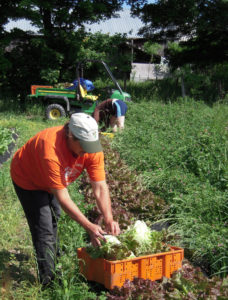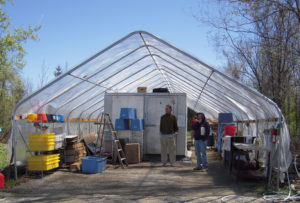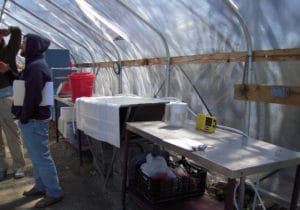Grubby Hands on Your Lettuce? Efficient and Safe Food Handling for Small-Scale Vegetable Producers
Since the bout of food safety scandals over the past few years, many wholesale buyers have begun requiring food safety certification. This poses several problems to farmers, and to small farmers in particular. Questions about what certification means, and when farmers need it, can be confusing.

Janet Mandeville of Mandeville Farm in Spencer, NY, harvests lettuce for a Wegman’s order. Photo by Molly Shaw
Molly Shaw, an extension fruit and vegetable specialist in the South Central NY Ag Team saw a role for the Cooperative Extension in this situation. In 2010, Northeast SARE endorsed this role with a partnership grant focusing on food safety issues with an emphasis on labor-efficient harvest and washing techniques. Rather than encourage certification, Molly’s project promotes sound and efficient on-farm food handling processes. Her aim is not to raise the numbers of small farmers with certified crops. Instead, with the help of a Northeast SARE Partnership grant, the number of small farmers who are eligible to be certified, and who see certification as approachable, will grow.
The SARE Project
In the initial phase of the project, Eric Yetter, the project manager, is spending time with harvesters on eight farms in New York State with exemplary food handling systems, observing, interviewing, and taking videos of their processes. These farms have years of experience developing efficient harvesting and washing practices that match their scale, and many have incorporated elements such as concrete rather than dirt washing room floors, doors to the washing rooms to prevent animal access, and maximally efficient line-ups for the washing and packaging process, to save on labor costs. Additionally, he is helping two farms to develop new wash stations which are cleaner and more efficient. A last farm will receive help to improve the existing set-up.

Project Manager Eric Yetter and Matthew Glenn of Muddy Fingers Farm discuss strategies for a well-laid out and organized wash station Photo by Molly Shaw
In the second phase of the project, field days and farmer meetings will spread the word about these good systems, and provide forums for other farmers to see first-hand and ask questions.
Generating the idea and application for the SARE grant was a team effort. In addition to Molly’s work from the CCE Tioga office, Matt LeRoux, of CCE Tompkins County, prepared a draft, Monika Roth, also of CCE Tompkins, reviewed it, and staff in both offices solicited letters of support from farmers. The grant goes primarily toward compensating Eric, the project manager, for his time. Materials and supplies include a scrub brush and hose nozzles for each participating farm, as well as more substantial equipment for the farms rebuilding their handling systems from scratch. Mileage, printings, publications, and meetings make up the rest of the budget.
The Food Safety Certification Quandary …
Many farmers are dubious about certification, Molly reports. “Part of the frustration is that it feels like someone in an office thought of [the rules], someone that doesn’t know what a farm is like, and I don’t think the rules are really based on scientific data.” Some aspects of certification are common-sense, Molly says, and regulations like prohibiting fresh manure in this season’s vegetable fields are already present in other systems, such as organic certification. Some requirements also bring much-needed attention to areas of production that most farmers take for granted, such as employee hygiene. But other rules make less sense.
The USDA took the concern about fresh manure, for example, and extrapolated a necessity to keep wild animals out of the fields, a measure which is not feasible for field-grown produce. “We can’t control birds flying over the field,” the farmers protest. The compromise for the certification process is that farmers must inspect their field for signs of wildlife before harvest, document the results, and take some measure to reduce wildlife damage during the growing season…a vague requirement, but one farmers can do. Documentationis the biggest hurdle for many farms—creating a written procedure to follow, and making a note on paper when you do what you said you’d do. Similarly, Molly asserts that all farmers she has ever visited wash their vegetables using potable water, but certification requires records of water test results each year, a requirement that seems cumbersome to many.

The wash station at Muddy Fingers Farm was simple and inexpensive, but works well for the farm’s needs. The owners have added a barrel washer since this photo was taken. Courtesy of Molly Shaw.
Some buyers, such as Wegmans, a large grocery chain based in upstate NY, require certification only for “high risk” items like lettuce, scallions, tomatoes, melons and herbs…..items that have been linked to food-borne illnesses in the past. . Others, such as Hannaford, require certification for all produce. Still others don’t require certification at all; many small farmers choose to sell only to these wholesalers, or through direct sales to customers. This limits the farmers’ options in the present, and rumors assert that there will soon be legislation mandating food safety certification of some kind.
… And How to Overcome It
Certification stymies many small farmers with its cost, paperwork, and documentation requirements, regardless of whether large changes in practice are required. Projects like Molly’s help by demystifying and providing support for various aspects of the certification process. All farmers, whether or not they are interested in food safety certification, are interested in reducing labor in the harvesting and washing process, so the dual nature of this project (efficiency and safe food handling practices) make it useful to all small scale vegetable farmers. Molly’s project addresses the first step, that is making sure farmers are using certifiable food handling systems.
Some of the next steps aid farmers in the application. For example, writing a food safety plan is a common hurdle. Many farmers don’t know that they have access to the rubric the inspector will use to score them on, or that inspectors are available to review their plans in advance. Molly reports that one farmer concluded, “Well, it’s just a lot of getting the words right.” These programs recognize that often times, certification is not about teaching farmers to do new things; it’s about speaking the same language as the evaluators, and communicating how the farm already fits the standard.


Cornell Small Farm Project. Spent many years in ORGANIC farm production in California and Idaho. I am proposing a USDA certified scaled processing facility in Southern Idaho. As you well know these facilities could never compete with existing SUPER PROCESSING facilities when it comes to efficiency. I propose that communities accept and pay for the increased cost of production thru a NON-Profit Co-Op organization. It seems reasonable to me that communities interested in maintaining LOCALLY GROWN and ORGANICALLY GROWN vegetable products learn that cost of production for these products will be significantly more expensive. With this assumption agreed upon we should move forward with a community supported NON-Profit Farmers and Consumers Co-OP. In my community, fund raisers for our local Animal Shelter raise close to a million dollars a year for its facility, I would assume that similar interest would exist for the capitalization and yearly operating costs shared by the entire community in an effort to pay farmers a break even income and to afford the community with locally grown year round. I will keep you notified on my progress if you desire. thanks. Bill Pereira/Big Chief Organics
By following these practices, small-scale vegetable producers can ensure their produce remains fresh, safe, and high-quality from the field to the consumer.